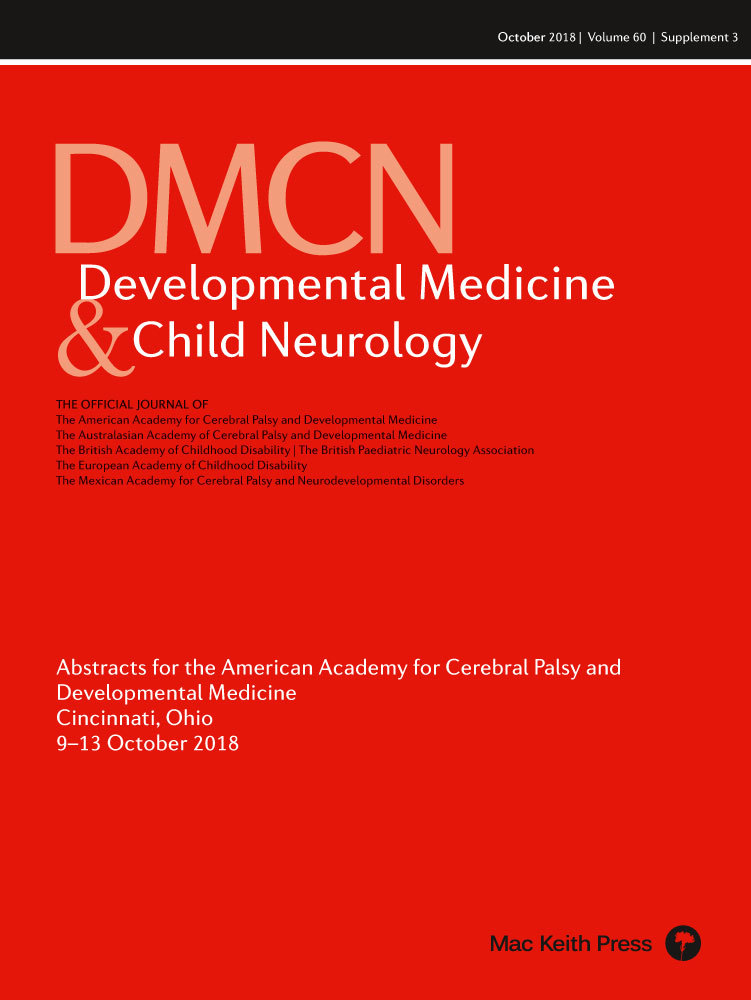Development curves of motor and daily activity performance of individuals with cerebral palsy from childhood into adulthood
SP17
M van Gorp1,2, M Roebroeck2,3, L van Wely4, V De Groot4, J Willem Gorter5, D-W Smits6,7, A Katrin Schmidt2,3,4, A Dallmeijer8
1VU University Medical Center, Amsterdam, Netherlands; 2Erasmus MC University Medical Center, Rotterdam, Netherlands; 3Rijndam Rehabilitation Institute, Rotterdam, The Netherlands; 4Department of Rehabilitation Medicine, VU University Medical Center, Amsterdam, The Netherlands; 5Department of Pediatrics, McMaster University, Ontario, Canada; 6Center of Excellence for Rehabilitation Medicine, Brain Center Rudolf Magnus, University Medical Center Utrecht, Utrecht University; 7De Hoogstraat Rehabilitation, Utrecht, the Netherlands; 8Department of Rehabilitation Medicine, VU University Medical Center, Amsterdam, The Netherlands
Background and Objective(s): In children with cerebral palsy (CP), limits of gross motor capacity decrease with increasing GMFCS level and these limits are approached around the age of 4 years. It is unknown whether this development is comparable to development of motor performance. The present study adds to this knowledge by determining long-term motor performance and also daily activity performance. We aim to describe development curves of motor and daily activity performance from childhood into adulthood of individuals with CP by functional severity level.
Study Design: Prospective cohort study.
Study Participants & Setting: Individuals with CP (n=421), aged 1–20 years at baseline, with GMFCS I-V, MACS I-V and 27% with intellectual disability (ID), were included. Participants were assessed up to four times at 1- or 2-year intervals and at a 13-year follow-up (21–34yrs, n=122 at 13y follow-up), resulting in 1428 observations.
Materials/Methods: Gross and fine motor performance and personal, domestic and community daily activity performance were assessed using the Vineland Adaptive Behavior Scales. Non-linear mixed effects analyses were used to describe development curves, characterized by a limit (average maximum score) and age90 (age when 90% of the limit was reached).
Results: Limits of gross and fine motor performance were significantly lower with each lower functional level (GMFCS or MACS). Children with GMFCS or MACS I-III reached age90s of gross and fine motor performance around 6–8 years. Those with lower functional levels (GMFCS IV and V) reached age90 for gross and fine motor performance at a younger age: at 2y4m (CI: 1y3m–4y3m) and 1y3m (CI: 0y2m–9y7m), respectively. Individuals with GMFCS I-III without ID had comparable limits of daily activity performance. Their age90s for daily activity performance were between 11–14 years (personal activities), 26–32 years (domestic activities) and 22–26 years (community activities). Individuals with ID reached lower limits of daily activity performance and approached their limits at a younger age.
Conclusions/Significance: Children with CP approach motor performance limits between 6–8 years. Individuals with GMFCS I-III without ID develop performance of daily activities into adolescence and adulthood. Severely functionally affected individuals have the least favourable development of motor performance and those with ID of daily activity performance. Health-care professionals should be aware of further development of motor performance in children with CP after they have reached their limit in motor capacity. Moreover, we recommend routine monitoring of individuals with CP for activity limitations into adulthood.




